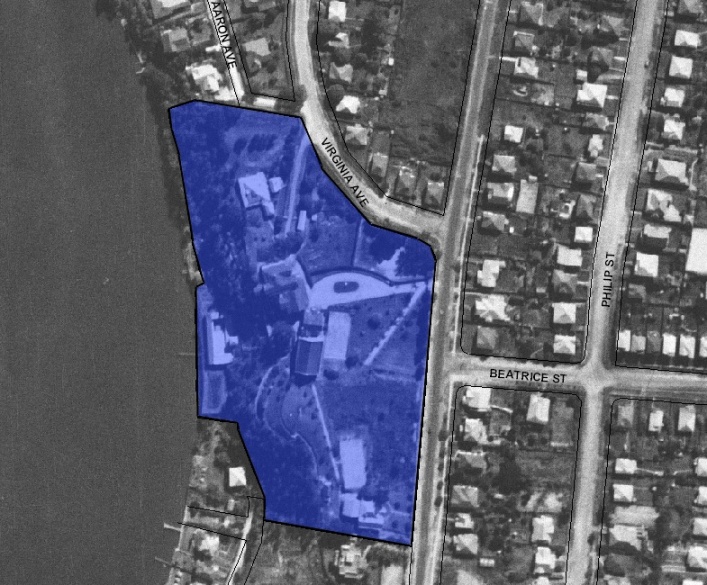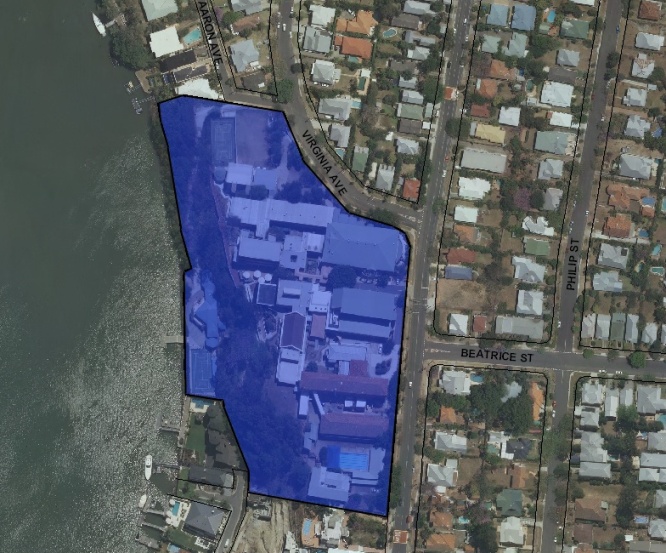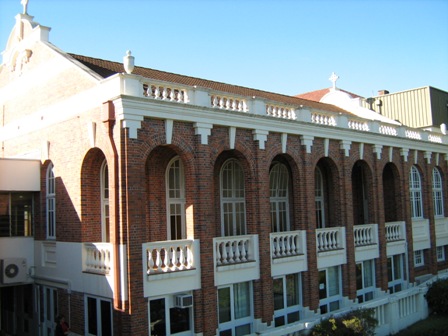Addresses
Type of place
School, Private school
Period
World War I 1914-1918
Style
Free Classical, Stripped Classical
Addresses
Type of place
School, Private school
Period
World War I 1914-1918
Style
Free Classical, Stripped Classical
Since its establishment in 1916 Lourdes Hill College has served an important social, religious and educational function for the area of Hawthorne and the Catholic faith in Brisbane and Queensland. The school hall, sited on a dominant hillside overlooking the Brisbane River, is a prominent and picturesque landmark visible from both northern and southern suburbs of Brisbane.
Lot plan
L86_SP120692
Key dates
Local Heritage Place Since —
Date of Citation —
Construction
Roof: Tile;Walls: Masonry
Criterion for listing
(E) Aesthetic; (E) Aesthetic; (G) SocialInteractive mapping
Lot plan
L86_SP120692
Key dates
Local Heritage Place Since —
Date of Citation —
Construction
Roof: Tile;Walls: Masonry
Criterion for listing
(E) Aesthetic; (E) Aesthetic; (G) SocialInteractive mapping
History
While the land the college currently occupies was acquired over time by the Archbishop, with the first land for the site being purchased by Duhig in 1914, it was the arrival of The Sisters of the Good Samaritan in 1916, at the request of Archbishop Dunne, which saw the foundation of the College proper.
The Sisters of the Good Samaritan originally stayed in a house in Lindsay Street until the present site of Lourdes Hill, purchased by Archbishop Duhig, was available. The first Lourdes Hill College students stayed in an adjacent house and went to school at Bulimba until the Convent and School Hall were built in 1916 and 1918 respectively. By 1919 increasing numbers of boarders prompted the purchase of a large residence at the top of the hill called "Nyanza". The further expansion of the school necessitated the purchase of another nearby residence, "The Cottage", which became the focus for the school's music activities and became known as "St Cecilia's". From commencement of the college there was and would remain a strong interaction between the school and the community in which was located.
The Hall, built 1919, although not visible from within the area, is a notable landmark from New Farm, Teneriffe and Newstead. The masonry and timber fence along the road frontage to Hawthorne Road and Virginia Ave creates a strong and unifying visual element to a disparate group of institutional buildings.
Description
The description of the place is limited to the agreed boundary attached to this citation and supplied by Bertoldi architects Pty Ltd.
The curtilage covers from beyond the river level water Sports complex including the stairway, balustrading wall (concrete fence) and walkway surrounding the wall, the grotto and importantly the Duhig Hall, identified on the plan as C Block. The curtilage also allows for important vista views, particularly cross-river views, of the prominently placed hall on the hill.
Stairway
The current stairway is recently constructed stairs. Its identification here is only included here to ensure that access to the lower level is retained in this manner. Not only does it maintain a direct link between Brisbane River and the School, it also recognises the significance of this access point to the river by the school and those involved with the school.
Balustrade, wall and walkway
The construction of the wall located between the hall and the stair to the river, provides for a usable and practicable space within a hilly terrain. The walkway in previous periods of the school afforded an important through fare to the stairway, which runs to the river, and buildings that were located at different ends of the site.
Clearly the balustrading was designed to compliment that of the hall. At a distance it helped show the extent of the grounds and reflect the importance of the school. The wall was instituted to provide a reasonably sized walking path along uneven terrain.
Grotto
The grotto is vine covered and is of masonry construction. Reputedly built around 1917, the grotto is intended to replicate as afar as possible the Lourdes Shrine in France. Within the grotto is an altar and religious icons. Access to the Grotto is restricted by steel gates which are adorned with cross on the top rails (x3 cross). Flanking the grotto is an arch.
Hall
The most prominent structure on the site, the hall presents as a tiled roofed, brick and masonry structure with arched verandahs on the western and eastern sides. The design of the structure utilises a number a number of notable building styles to present the hall as classical structure representing the timeless faith of the religion of the school. The verandah arches, within interpretive columns, mimic buttresses presenting the hall as a grand building. The high roof and sharp pitch give the hall elevation, as does the north and south high end pediments, which are toped by crosses.
Painted concrete balustrading which runs at the bottom of the verandah arches and atop of the pediment of the structure give a classical appearance. These pediments are toped by urns at each end. Apart from external entries to the verandahs, which generally serve as the main entry points for students to the hall, access to the hall is through a series (8 each side) of smaller double glass doors. Half round sash windows are located above these opaque glass doors.
The hall presents as a three level building with internal features of particular note including the half round vaulted ceiling and wood panelling which runs the length of the hall.
Though immediately adjacent to later structures on both the northern and southern sides, care has been taken to distinguish the adjoining structures from the hall. This provides a visual appearance making the original hall discernable as an individual building yet part of the overall educational and religious complex of Lourdes Hill College. The balustrade on the lower wall for example compliments the balustrading on the hall.
Statement of significance
Relevant assessment criteria
This is a place of local heritage significance and meets one or more of the local heritage criteria under the Heritage planning scheme policy of the Brisbane City Plan 2014. It is significant because:
Citation prepared by — Brisbane City Council (page revised September 2020)



